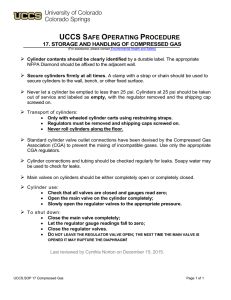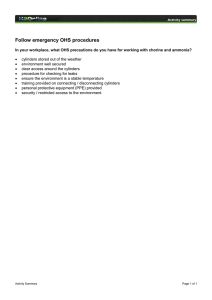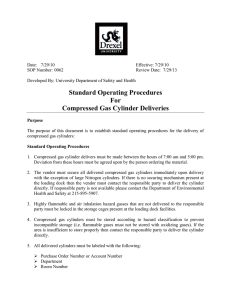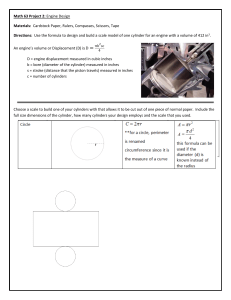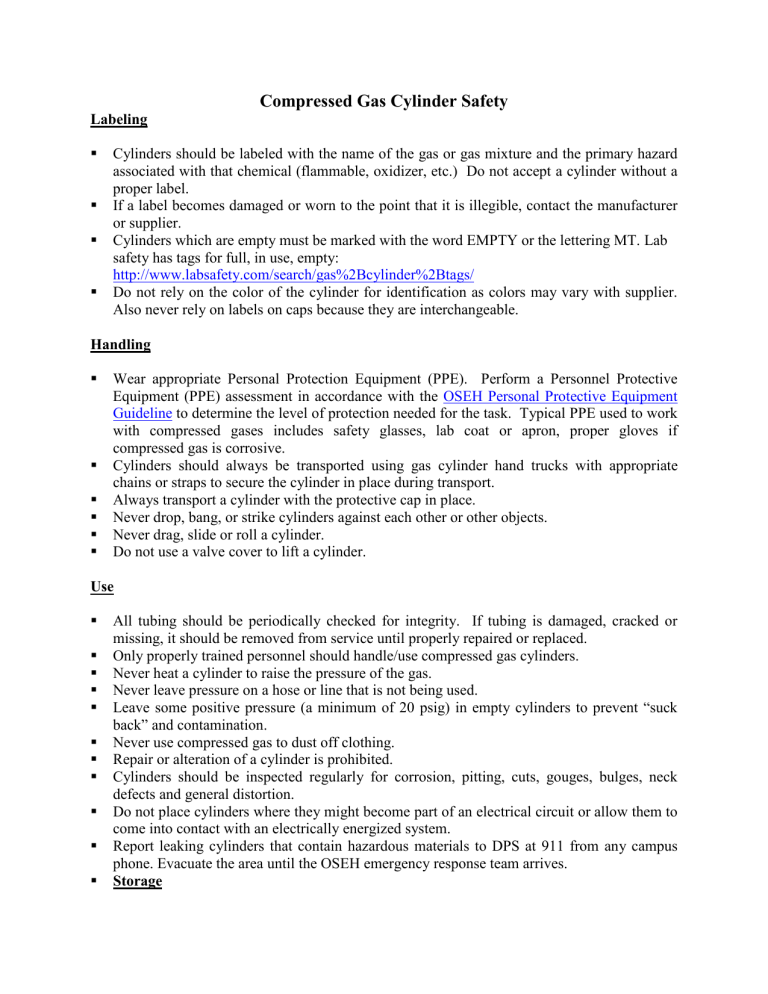
Compressed Gas Cylinder Safety Labeling Cylinders should be labeled with the name of the gas or gas mixture and the primary hazard associated with that chemical (flammable, oxidizer, etc.) Do not accept a cylinder without a proper label. If a label becomes damaged or worn to the point that it is illegible, contact the manufacturer or supplier. Cylinders which are empty must be marked with the word EMPTY or the lettering MT. Lab safety has tags for full, in use, empty: http://www.labsafety.com/search/gas%2Bcylinder%2Btags/ Do not rely on the color of the cylinder for identification as colors may vary with supplier. Also never rely on labels on caps because they are interchangeable. Handling Wear appropriate Personal Protection Equipment (PPE). Perform a Personnel Protective Equipment (PPE) assessment in accordance with the OSEH Personal Protective Equipment Guideline to determine the level of protection needed for the task. Typical PPE used to work with compressed gases includes safety glasses, lab coat or apron, proper gloves if compressed gas is corrosive. Cylinders should always be transported using gas cylinder hand trucks with appropriate chains or straps to secure the cylinder in place during transport. Always transport a cylinder with the protective cap in place. Never drop, bang, or strike cylinders against each other or other objects. Never drag, slide or roll a cylinder. Do not use a valve cover to lift a cylinder. Use All tubing should be periodically checked for integrity. If tubing is damaged, cracked or missing, it should be removed from service until properly repaired or replaced. Only properly trained personnel should handle/use compressed gas cylinders. Never heat a cylinder to raise the pressure of the gas. Never leave pressure on a hose or line that is not being used. Leave some positive pressure (a minimum of 20 psig) in empty cylinders to prevent “suck back” and contamination. Never use compressed gas to dust off clothing. Repair or alteration of a cylinder is prohibited. Cylinders should be inspected regularly for corrosion, pitting, cuts, gouges, bulges, neck defects and general distortion. Do not place cylinders where they might become part of an electrical circuit or allow them to come into contact with an electrically energized system. Report leaking cylinders that contain hazardous materials to DPS at 911 from any campus phone. Evacuate the area until the OSEH emergency response team arrives. Storage Compressed gas cylinders must be secured in an upright position away from excessive heat, highly combustible materials, and areas where they might be damaged or knocked over. A chain, bracket or other restraining device shall be used at all times to prevent cylinders from falling. The securing device must be connected to a wall or bench mounted device. Securing devices for lecture bottles can be purchased from gas suppliers or safety equipment companies. Caps used for valve protection must always be securely fastened, unless the cylinder is being used. Empty gas cylinders must also be stored securely with the valve protection cap in place. Cylinders must be stored in dry, well-ventilated areas. Closets and lockers would not generally be acceptable storage locations. Cylinders should not be exposed to flames, sparks, or any sources of heat or ignition. Cylinders should be maintained at temperatures below 125◦F and stored out of direct sunlight. Cylinders should not be exposed to continuous dampness, stored near salt or other corrosive chemicals or fumes. Cylinders must not be stored in hallways, corridors, stairwells or near elevators. Unobstructed access must be maintained around the cylinders. Place cylinders in a location where they will not be subject to mechanical or physical damage, heat, or electrical circuits to prevent possible explosion or fire. Outdoor storage must be protected to prevent rusting of the cylinders. Cylinders should be protected against tampering. Disposal Close and tighten valves and replace safety caps on cylinders. Contact the vendor/supplier to obtain specific guidelines for shipment of cylinders to be returned to them. Contact Occupational Safety and Environmental Health (OSEH) Hazardous Materials Management (734-763-4568) to arrange for removal of cylinders that cannot be returned to the supplier/vendor. To dispose of empty lecture bottles that will not be returned to the vendor, write “empty” on the outside of each cylinder and place in a cardboard box. Complete a hazardous waste manifest, listing the contents of the box, and contact OSEH Hazardous Materials Management at 3-4568 to schedule a pickup. Regulators and Valves Use only the regulator designed for the gas being used. Do not force or change connections. Always use a cylinder wrench or other tightly fitting wrench to tighten the regulator nut and tube connections. Lecture bottles use universal threads and valves which may be interchangeable. Label all associated equipment with the gas name to prevent unintentional mixing of incompatible materials. Repair or alteration of the valve or safety relief devices is prohibited. A visual inspection of valves and regulators should be performed before each usage to detect any damage, cracks, corrosion, or other defects. Consult the cylinder, regulator or gas supplier for recommended valve and regulator maintenance schedules. If the regulator is dropped, it should be sent to the supplier for servicing. Do not use Teflon tape because it will not seal the connection and may cause the regulator to clog or contaminate the gas stream. Open cylinder valves slowly. Point the valve opening away from yourself and others. Never use a wrench or hammer to open or close a hand wheel type cylinder valve. When removing a regulator from a cylinder, close the cylinder valve first, and then release the pressure from the cylinder. Special Precautions for Flammable Gas – Cylinders of flammable gas must be stored away from flammable liquids, combustible materials, oxidizers, open flames, sparks and other sources of heat or ignition. Maintain a distance of at least 20-feet from these materials unless separated by a noncombustible wall, not less than 5-feet high, having a fire-resistance rating of ½-hour. All lines and equipment associated with flammable gas systems must be grounded and bonded. Flash arrestors are designed to prevent a flash-back, should it occur, in a line containing a flammable gas. Portable fire extinguisher should be available in the area of use and storage. Use spark- proof tools when working with flammable gas. Do not leave “flow” experiments unattended. Do not use acetylene at operating pressures over 15 psig. Never use copper fittings or tubing on acetylene tanks. Special Precautions for Oxidizing Gas – Cylinders of oxygen and other oxidizers must be stored at least 20-feet from fuel-gas or other combustible materials unless separated by a noncombustible wall, not less than 5-feet high, having a fire-resistance rating of ½-hour. All equipment used for oxidizing gases must be cleaned with oxygen-compatible materials free from oils, greases and other contaminants. Do not use oily hands or gloves when handling cylinders. The reaction between oxygen and hydrocarbons can be violent, even when small quantities are involved. Special Precautions for Corrosive Gas – Avoid contact with skin and eyes. An emergency shower and eyewash must be installed within 50 feet where corrosive materials are used. Metals become brittle when used in corrosive gas service, check equipment and lines frequently for leaks.

